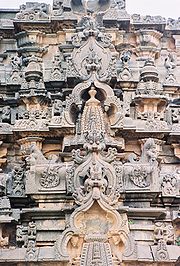
Kirthimukha
Encyclopedia

Iconography
Iconography is the branch of art history which studies the identification, description, and the interpretation of the content of images. The word iconography literally means "image writing", and comes from the Greek "image" and "to write". A secondary meaning is the painting of icons in the...
of India
India
India , officially the Republic of India , is a country in South Asia. It is the seventh-largest country by geographical area, the second-most populous country with over 1.2 billion people, and the most populous democracy in the world...
n and Southeast Asian temple architecture. In Southeast Asia
Southeast Asia
Southeast Asia, South-East Asia, South East Asia or Southeastern Asia is a subregion of Asia, consisting of the countries that are geographically south of China, east of India, west of New Guinea and north of Australia. The region lies on the intersection of geological plates, with heavy seismic...
it is often referred to as Kala and in China
China
Chinese civilization may refer to:* China for more general discussion of the country.* Chinese culture* Greater China, the transnational community of ethnic Chinese.* History of China* Sinosphere, the area historically affected by Chinese culture...
it is known as T'ao t'ieh (Monster of Greed).
Origin and characteristics
The word mukha in SanskritSanskrit
Sanskrit , is a historical Indo-Aryan language and the primary liturgical language of Hinduism, Jainism and Buddhism.Buddhism: besides Pali, see Buddhist Hybrid Sanskrit Today, it is listed as one of the 22 scheduled languages of India and is an official language of the state of Uttarakhand...
refers to the face while kīrti means "fame, glory".
Kirtimukha has its origin in a legend from the Skanda Purana
Skanda Purana
The Skanda Purana is the largest Mahapurana, a genre of eighteen Hindu religious texts. The text is devoted mainly to the lilas of Kartikeya , a son of Shiva and Parvati. It also contains a number of legends about Shiva, and the holy places associated with him...
when Jalandhara, an all-devouring monster created from Shiva
Shiva
Shiva is a major Hindu deity, and is the destroyer god or transformer among the Trimurti, the Hindu Trinity of the primary aspects of the divine. God Shiva is a yogi who has notice of everything that happens in the world and is the main aspect of life. Yet one with great power lives a life of a...
, third eye willingly ate his body starting by its tail as per Lord Shiva's order, who pleased with the result gave it the name face of glory. Some authors have compared the Kirtimukha myth with the Greek myth of Ouroboros
Ouroboros
The Ouroboros is an ancient symbol depicting a serpent or dragon eating its own tail. The name originates from within Greek language; οὐρά meaning "tail" and βόρος meaning "eating", thus "he who eats the tail"....
.
The Kirtimukha is often used as a decorative motif
Motif (art)
In art, a motif is an element of a pattern, an image or part of one, or a theme. A motif may be repeated in a design or composition, often many times, or may just occur once in a work. A motif may be an element in the iconography of a particular subject or type of subject that is seen in other...
surmounting the pinnacle of a temple or the image of a deity, especially in South India
South India
South India is the area encompassing India's states of Andhra Pradesh, Karnataka, Kerala and Tamil Nadu as well as the union territories of Lakshadweep and Pondicherry, occupying 19.31% of India's area...
n architecture. This face is sometimes assimilated to, or confused with, another sculptural element, the lion face (Simhamukha). However, in order to be a Kirtimukha it has to be engaged in swallowing, for the Kirtimukha is the figure of the "all consuming"
This monstrous face with bulging eyes sits also as an embellishment over the lintel
Lintel (architecture)
A lintel can be a load-bearing building component, a decorative architectural element, or a combined ornamented structural item. It is often found over portals, doors, and windows.-Structural uses:...
of the gate to the inner sanctum in many Hindu temples signifying the reabsorption that marks the entry into the temple. Mostly it is only a face, although in some places its arms are portrayed as well.

